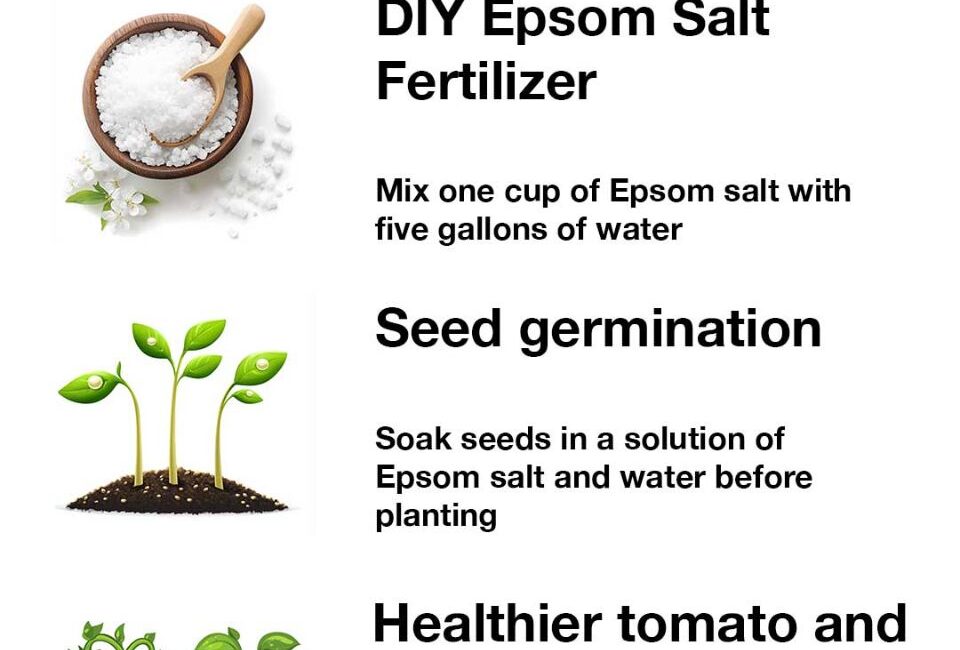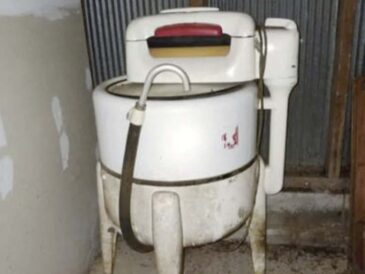Epsom salt is an affordable and versatile gardening tool that can help enhance the growth and health of your plants. Comprised of magnesium sulfate, it provides essential nutrients that plants need for optimum health. While it may be better known for its use in baths and home remedies, Epsom salt has gained recognition in the gardening world for its ability to improve soil structure, promote plant growth, and prevent common gardening problems.
In this article, we’ll explore 12 top Epsom salt gardening hacks to help you get the most out of your plants and improve the overall productivity of your garden. These tricks range from boosting plant health to addressing specific issues with common garden plants. Whether you’re a novice gardener or an experienced horticulturist, these Epsom salt tips will prove invaluable in your gardening journey.
1. Boost Flowering and Fruit Production
One of the most well-known uses of Epsom salt in gardening is to encourage flowering and fruit production. Magnesium is an essential nutrient that helps plants produce strong blooms and a bountiful harvest. The addition of Epsom salt to the soil increases magnesium levels, which improves photosynthesis and helps plants produce more flowers and fruits.
How to use it:
- Add 1 tablespoon of Epsom salt per foot of plant height and mix it into the soil around your flowering or fruiting plants, like tomatoes, peppers, or roses.
- Alternatively, dissolve 2 tablespoons of Epsom salt in a gallon of water and use it as a foliar spray on your plants every few weeks during the growing season.
Benefits:
- Promotes healthier and more vibrant flowers.
- Increases fruit set and improves fruit size.
- Enhances the overall growth and vitality of plants.
2. Improve Soil Structure
Epsom salt is a great tool for improving the structure of your garden soil, particularly in areas with heavy clay or poor-draining soil. It helps to loosen the soil, allowing water, air, and nutrients to penetrate more effectively.
How to use it:
- Mix 1 cup of Epsom salt with 1 gallon of water and apply it to your garden soil once a month.
- For larger areas, add Epsom salt directly to the soil at a rate of 1 cup per square yard and work it into the top 2-3 inches of soil.
Benefits:
- Improves soil drainage.
- Increases aeration in compacted soils.
- Enhances the absorption of nutrients and water.
3. Prevent Blossom-End Rot in Tomatoes
Blossom-end rot is a common problem in tomato plants, characterized by dark, sunken spots at the bottom of the fruit. It’s usually caused by a calcium deficiency, which can be corrected with the use of Epsom salt. Although Epsom salt doesn’t directly supply calcium, magnesium helps to improve the uptake of calcium, reducing the risk of blossom-end rot.
How to use it:
- When planting tomatoes, mix 1-2 tablespoons of Epsom salt into the soil at the base of the plant.
- Alternatively, dissolve 1 tablespoon of Epsom salt in 1 gallon of water and use it as a weekly foliar spray on your tomato plants.
Benefits:
- Reduces the occurrence of blossom-end rot in tomatoes and other fruiting plants.
- Enhances the plant’s ability to take up calcium.
4. Enhance Seed Germination
Epsom salt can give your seeds the boost they need to germinate more effectively. Magnesium plays a crucial role in the production of chlorophyll, which aids in photosynthesis. This process helps seeds develop healthier root systems and foliage when they sprout.
How to use it:
- Soak your seeds in a solution of 1 tablespoon of Epsom salt per gallon of water for 30 minutes before planting.
- This will help improve seedling growth and reduce transplant shock when the seedlings are ready to go into the garden.
Benefits:
- Encourages faster germination and healthier seedlings.
- Strengthens plant growth from the very beginning.
5. Repel Pests and Bugs
Epsom salt can help deter pests like slugs and snails, which are often found munching on your plants. The salt creates a barrier around your plants that irritates pests’ soft bodies, encouraging them to go elsewhere.
How to use it:
- Sprinkle Epsom salt around the base of plants or along garden pathways where you’ve noticed pests.
- Reapply after rain or watering to maintain the barrier.
Benefits:
- Naturally repels common garden pests.
- Safe and non-toxic alternative to chemical pesticides.
6. Improve Lawn Health
Your lawn will benefit from the addition of Epsom salt, which helps to promote stronger grass growth and a healthier lawn. Magnesium improves photosynthesis, leading to lush green grass with deeper roots.
How to use it:
- Apply 1 cup of Epsom salt per 100 square feet of lawn.
- Dissolve in water and use a lawn sprayer to distribute the solution evenly.
Benefits:
- Encourages healthy grass growth.
- Enhances the green color of your lawn.
- Strengthens the roots and resilience of grass.
7. Revive Plants with Transplant Shock
Transplanting can be stressful for plants, causing them to go into shock as they adjust to new soil. Epsom salt helps ease transplant shock by encouraging faster root development and better nutrient absorption.
How to use it:
- Mix 1 tablespoon of Epsom salt with 1 gallon of water and use it to water plants immediately after transplanting.
- You can also mix the Epsom salt into the soil before planting to help the roots establish more quickly.
Benefits:
- Reduces transplant shock and promotes faster acclimatization to new environments.
- Encourages healthy root growth in new plants.
8. Fertilize Houseplants
Houseplants often suffer from nutrient deficiencies due to limited soil space. Epsom salt is a great way to provide essential nutrients, particularly magnesium, to your indoor plants, promoting lush foliage and vibrant growth.
How to use it:
- Mix 1 tablespoon of Epsom salt in a gallon of water and use it to water your houseplants once a month.
- You can also add Epsom salt to your potting mix before planting to ensure your plants receive the necessary nutrients.
Benefits:
- Improves overall plant health and appearance.
- Enhances green foliage and overall growth in houseplants.
9. Encourage Stronger Root Growth in Trees and Shrubs
Epsom salt can improve the growth of trees and shrubs by encouraging stronger root systems. The added magnesium helps plants better absorb phosphorus, which is crucial for root development.
How to use it:
- Sprinkle 1 cup of Epsom salt around the base of trees and shrubs.
- Water thoroughly to help the salt seep into the soil and be absorbed by the roots.
Benefits:
- Promotes stronger, healthier root systems.
- Enhances overall plant growth and vitality.
10. Green Up Yellowing Leaves
Yellowing leaves are often a sign of magnesium deficiency, which can be addressed by using Epsom salt. Magnesium helps plants produce chlorophyll, the green pigment responsible for photosynthesis.
How to use it:
- Dissolve 2 tablespoons of Epsom salt in a gallon of water and apply it to your plants as a foliar spray or water solution.
- Apply once a month or as needed to improve the color of the leaves.
Benefits:
- Helps restore the green color in yellowing leaves.
- Corrects magnesium deficiencies quickly.
11. Enhance Rose Health
Roses are especially sensitive to magnesium deficiencies, which can result in poor flowering and unhealthy growth. Epsom salt helps boost rose health, promoting vibrant blooms and strong growth.
How to use it:
- Mix 1 tablespoon of Epsom salt with a gallon of water and water your roses with the solution.
- You can also sprinkle Epsom salt around the base of your rose bushes and lightly work it into the soil.
Benefits:
- Promotes vibrant rose blooms.
- Improves the overall health and growth of roses.
12. Improve the Flavor of Vegetables
Certain vegetables, like tomatoes and peppers, can benefit from the application of Epsom salt, which boosts the production of sugars and enhances the flavor of your crops.
How to use it:
- Apply Epsom salt to your vegetable garden by sprinkling 1 tablespoon of Epsom salt per plant and working it into the soil.
- You can also use it as a foliar spray, diluting 2 tablespoons in a gallon of water.
Benefits:
- Enhances the flavor of vegetables.
- Promotes sweeter, tastier crops.
Conclusion
Epsom salt is a gardening secret that can improve the health, growth, and productivity of your plants. Whether you’re looking to boost flowering, prevent pest problems, or improve soil structure, Epsom salt offers a natural and affordable solution for gardeners. With these 12 top Epsom salt gardening hacks, you can address a variety of common gardening challenges and enjoy a thriving, healthy garden year-round.




